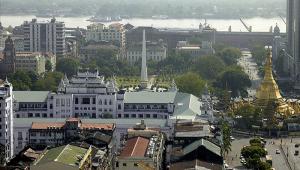Web_Yangon_shutterstock_307750499.jpg

Yangon, Myanmar at night
The fund said greater efforts to cut costs and generate revenue, in order to keep the deficit in check, are in order.
In its World Economic Outlook, the fund had anticipated Myanmar’s to be the fastest growing economy globally in 2016, with growth of 8.6%. But following a recent visit to the country it now estimates that in the 2015/16 financial year, which ran until 31 March, its economy will have expanded by 7%, rebounding to 8% in 2016/17.
After installing a civilian government and transitioning smoothly to democracy earlier this year, Myanmar’s already booming economy was expected to benefit as the country emerged from decade’s worth of isolation.
But Yongzheng Yang, who led the IMF’s mission to the country, explained that last year’s floods, the pre-election environment, weak external demand and low prices for Myanmar’s exports had dampened this somewhat.
He noted the fund anticipates a rebound this year as the impact of the floods dissipates and investment increases. “However economic vulnerabilities remain,” he continued, highlighting inflationary pressures, a high trade deficit in the current account and rapid credit growth over recent years that may have weakened banks’ balance sheets.
“Against this background, maintaining macroeconomic stability should remain a top priority for economic policy,” he said.
The fund said Myanmar needs to tighten its belt and raise government revenues in order to keep the deficit below 4.5% of GDP and the debt at a “low risk of distress”.
He said recent improvement in tax administration towards this aim is commendable, but more efforts to generate revenue will be necessary.
Other suggestions included banking reforms, including strengthening regulation and supervision and measures to mop up excess liquidity.
Myanmar was hit by widespread floods last summer, some of the worst in decades. All but one of the country’s states were affected, 100 people were killed and farmlands and crops worth an estimated $200m were destroyed.
Rice exports were halted and millions of dollars of infrastructure left in disrepair. The government estimated the total damage would cost $1.51bn – 3.1% of the country’s GDP in 2014/15.












